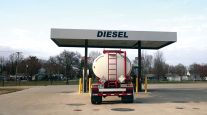Diesel Rises 4.3¢ to $2.274
This story appears in the June 1 print edition of Transport Topics.
Rising crude oil prices helped drive the average U.S. retail price of diesel fuel up 4.3 cents last week to $2.274 a gallon, while higher demand tied to increased summer driving pushed gasoline up nearly three times as much, the Energy Department reported.
The 12.6-cent rise in gasoline, to $2.435, was the seventh straight increase, moving the average 45% higher than at the start of 2009. Price changes this year have been kinder to trucking fleets, as diesel is 1.7 cents a gallon lower than it was in January. However, diesel has moved up only 5.3 cents since gasoline prices surged 38.9 cents from late March, DOE said after its May 25 survey of fueling stations.
Diesel prices are steadier because “we are awash in distillates worldwide,” Energy Department analyst Neil Gamson told Transport Topics. The steady rise in diesel stockpiles that he described contrasts with gasoline stockpiles that have been shrinking since early April.
Still, Larry Anderson, president of A&A Express Inc., Brandon, S.D., said he is concerned about the recent increases, especially because freight volumes are under pressure.
“I don’t see a reason for it,” said Anderson, who still worries that fleets could face increases in another way — through some form of carbon tax imposed on trucking.
“If Congress increases taxes on diesel fuel, all trucking companies will pass it along to customers, and their costs will go up along with trucking,” Anderson cautioned.
On the positive side, diesel now sits 52% below this time last year, when it hit $4.723 a gallon.
The drop in diesel means that fleets’ fuel costs are $1.84 billion a week lower than at this time last year, using American Trucking Associations’ estimate of 752 million gallons used by trucks. The 38% drop in gasoline prices from $3.937 a gallon in May 2008 represents a saving of $427.5 million for fleets using that fuel.
Anderson said A&A, whose fleet is focused on the refrigerated market, was as prepared as it could be for a spike in diesel prices, because the company cut its top speed to 65 mph three years ago. It also has purchased auxiliary power units and bought more fuel-efficient trucks and tires to keep a lid on expenses.
“Gas is rising with driving season and rising crude prices,” DOE’s Gamson said. On the other hand, diesel prices are less volatile now because the fuel is used globally year-round, rather than subject to seasonal spikes, he explained.
The latest evidence of a pickup in driving was the AAA’s report last week that 1.5% more Americans drove on trips of more than 50 miles over the Memorial Day weekend, compared with this time last year.
The significant drop in fuel prices since last summer is contributing to increased driving, said Mary Novak, director of North American Energy Services for IHS Global Insight, Lexington, Mass.
Another way that both analysts explained faster-rising gasoline prices is that profit margins for refining gasoline are rising. Novak said that those margins have nearly doubled on gasoline in recent weeks, while they were cut in half on diesel.
Gamson cited expectations that a U.S. economic recovery could begin later this year as another reason for the recent surge in crude, which has nearly doubled since hitting a Dec. 21 low of $33.87.
The price of benchmark West Texas Intermediate, or WTI crude, topped $65 a barrel late last week. Analysts said that prices were being driven up by comments from oil ministers in the Organization of Petroleum Exporting Countries, who met last week in Vienna, Austria.
“The price rise is a function of optimism that better things are coming in the future,” Saudi Arabian Oil Minister Ali al-Naimi told Bloomberg News on May 26. “If demand picks up, then why do anything? The fundamentals are strengthening.”
Besides OPEC ministers, a U.S. business economist group said last week they believe a recovery is coming, probably in the third quarter.
Another reason for the recent rise is investors have flocked to commodities such as oil in hopes that prices will rise further, Gamson added.
Novak said she expected that prices for both gasoline and diesel fuel should drop in the coming weeks because current crude prices have gotten ahead of underlying demand.
“The only way that diesel goes down is if crude goes back down,” she said.
Novak said she believes crude could fall under $50 a barrel later this year, which would bring diesel prices back down to the $2.10-to- $2.15-a-gallon range.




